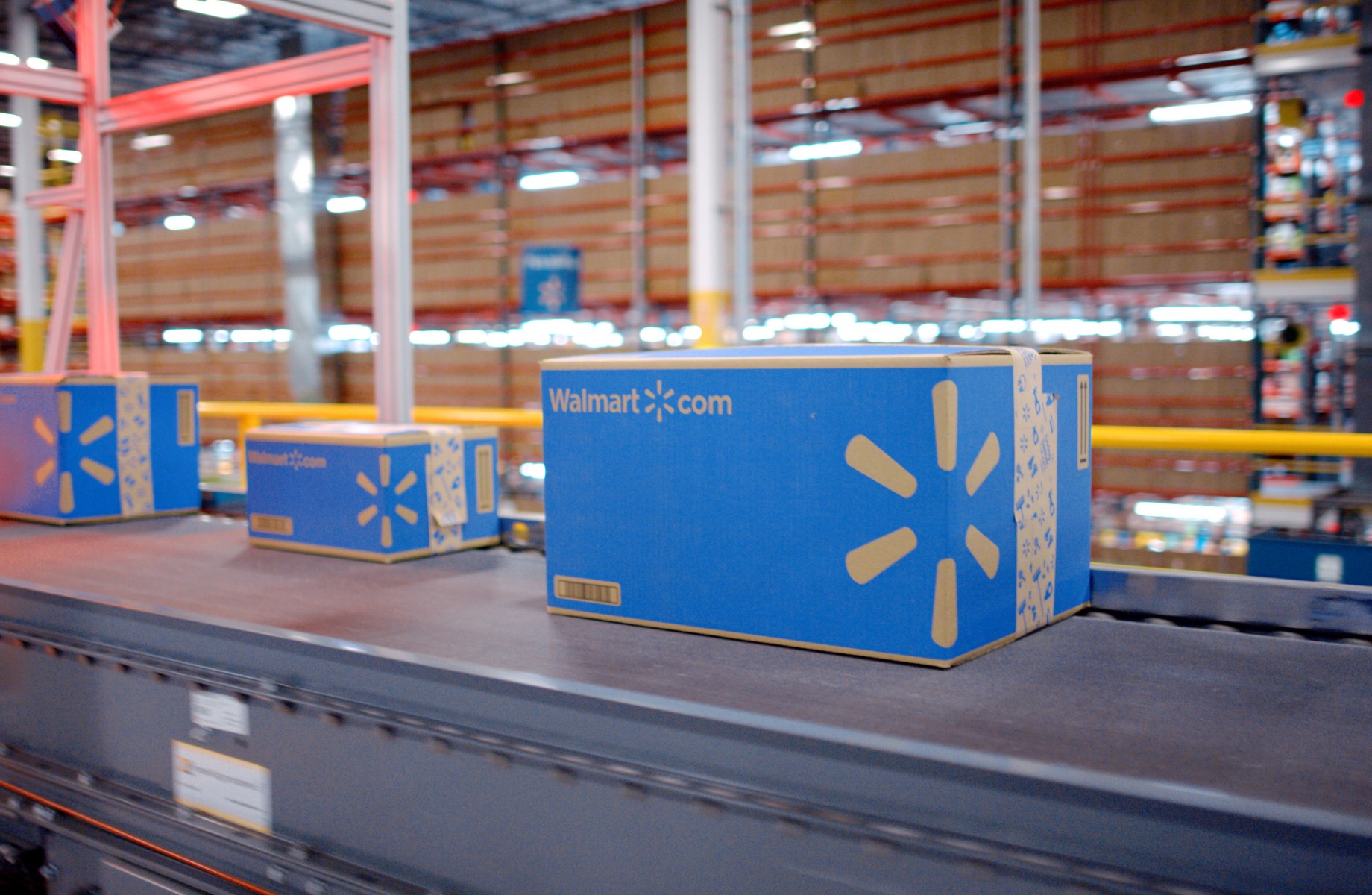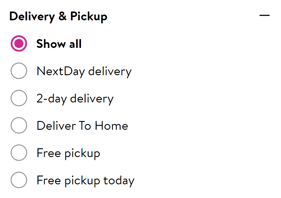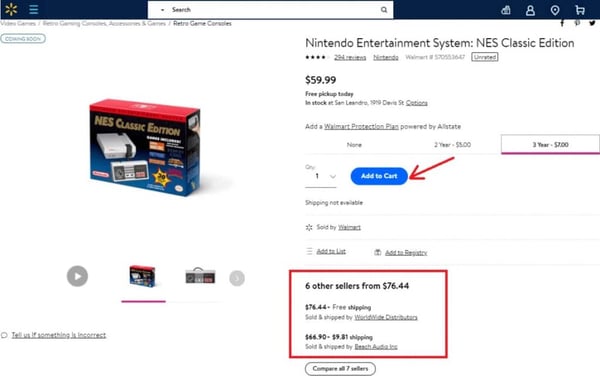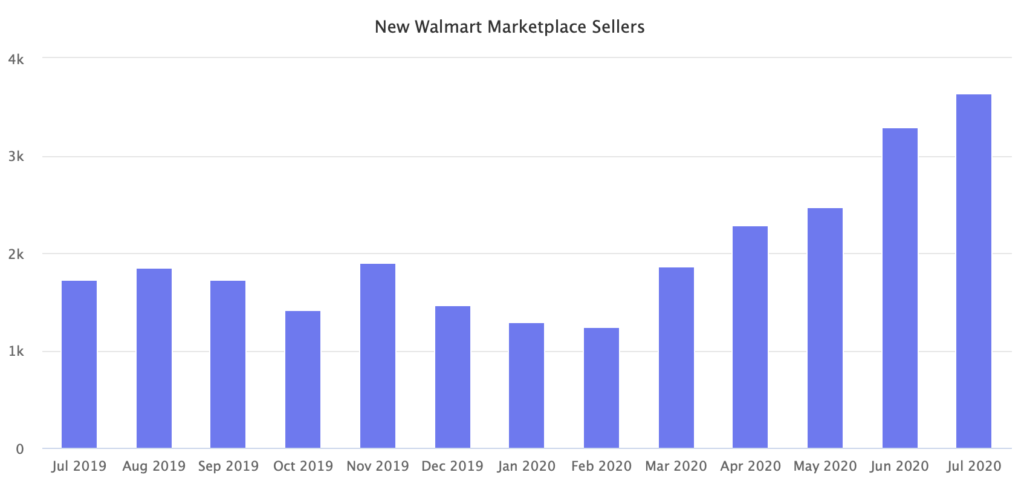

A guide to Walmart Marketplace, how it compares to Amazon and how brands can take advantage of this rapidly growing platform
With pressure being heavily placed on eCommerce sales since the beginning of 2020, many brands have been faced with the choice to sink or swim. Digital brands are being forced to experiment with new selling channels and strategies in order to keep up with this pressure and demand. One retailer that has risen to the challenge is Walmart and its affiliate seller platform, Walmart Marketplace. The brick and mortar giant announced that online sales grew 97% during Q2 of 2020 and is investing right back into digital by increasing the number of online fulfillment centers, introducing Walmart advertising services, partnering with Shopify, and launching Walmart+ (a same-day delivery service that directly competes with Amazon’s Prime Now). So how exactly does Walmart Marketplace work, and more importantly, should you be there?
Contents:
- What is Walmart Marketplace?
- Types of sellers on Walmart Marketplace
- How to become a seller on Walmart Marketplace
- Walmart Marketplace vs. Amazon Marketplace
- Why should brands sell on Walmart Marketplace?
- How can brands win on Walmart Marketplace?
What is Walmart Marketplace?
Walmart Marketplace is a large-scale cross-category digital retail platform owned and operated by Walmart that sells products from Walmart private label brands as well as approved affiliate third-party vendors. By adopting this model, Walmart is able to offer a wider range of products, brands and selections to its vast customer base. The marketplace offers over 35 product categories, from personal care to electronics to apparel, with products appearing directly in the search results of Walmart’s main website, walmart.com.
The first version of the Walmart Marketplace was created in 2009 with the idea of inviting various retailers and merchants to sell their products on the Walmart website. For example, some of the initial retailers on Walmart Marketplace were eBags and Wayfair. But over the years, the platform has shifted to include more third-party and individual sellers, now amounting to over 50,000 brands.
Types of sellers on Walmart Marketplace
As Walmart has evolved its marketplace strategies in the past several years, it also has defined different types of sellers than can apply to become digital marketplace vendors:
- First-party (1P) – This type of seller sends Walmart products in bulk orders at wholesale prices. Then, when it comes to the marketplace, Walmart is listed as the seller and is in control of all digital aspects like listing optimization, advertising and pricing. These sellers are only in control of their relationship with Walmart and providing them with products.
- Third-party (3P) – This type of seller uses Walmart Marketplace as a channel to sell their products, but they remain in control. On the Walmart website, items will be shown as owned and shipped by the individual brand, rather than Walmart. These sellers are responsible for listing optimization, pricing and fulfillment.
- Dropship vendor (DSV) – This type of seller works similarly to 1P sellers, however, products are not ordered in bulk. Instead, Walmart sends the vendor each order that needs to be fulfilled as they are placed, and the vendor then sends the item to the customer.
Additionally, all types of sellers have the option to enroll in Walmart Fulfillment Services (WFS). This is a paid service, similar to Amazon Fulfillment Services, that allows sellers to send inventory to a Walmart fulfillment center. Then, Walmart handles all deliveries, returns and customer service inquiries on the seller’s behalf.
How to become a seller on Walmart Marketplace
In order to begin selling on Walmart Marketplace, vendors must first go through an application and setup process that may take several weeks. The overarching process is as follows:
- Apply
The first step to selling on Walmart Marketplace is filling out the application found on their website and waiting for an approval notification. While there is no secret formula to being accepted, a few things Walmart looks for when considering new sellers include:
- Impressive sales projections
- Competitive pricing
- Positive customer reviews
- Quality of assortment
- Defect rates of less than 1%
- Fast and reliable shipment methods
- Strong brand awareness and equity
- Register
After receiving the approval email, sellers will be asked to submit the proper paperwork to register their partnership with Walmart Marketplace. This includes providing tax forms, bank account information and shipping details. - Complete profile
When all paperwork is approved, the rest of the Partner Profile can be completed. Sellers must input all of their company information and verify their bank information is compatible with payments prior to making any sales. - List products
Following company profile authorization, brands can begin listing individual items from their product portfolios. At the very least, each product listing should include a category assignment, description and photos. Walmart Marketplace also allows sellers to preview all of their product listings to make sure they are up to standard and error-free prior to publishing. - Launch
Once all information has been verified and products are listed, the seller account can be officially launched. It may take up to 24 hours to go live, as Walmart reviews all new profiles, but once the account is launched, sales can be made.
Walmart Marketplace vs. Amazon Marketplace
When brands are determining where to sell their products and focus their eCommerce efforts, it is important to consider the similarities and differences between Walmart Marketplace and the current leader in the field, Amazon Marketplace.
This table shows a brief comparison of both marketplaces:
| Walmart Marketplace |
Amazon Marketplace |
|
| # of sellers |
~50,000 sellers |
~2 million sellers |
| # of product categories |
~35 product categories |
~65 product categories |
| Fee schedule |
No membership fee for Walmart Marketplace. However, sellers are charged a referral fee of 6-20% per sale depending on the product category. For a detailed list of fees by category, click here. |
$39.99 per month, professional selling account fee |
| Fulfillment methods |
Fulfillment by Walmart (FBW) – uses a combination of store distribution centers, fulfillment centers and a transportation fleet. Marketplace sellers can also choose to self-fulfill orders. |
Fulfillment by Amazon (FBA) – uses a combination of a Merchant Fulfillment Network, Seller-Fulfilled Prime and physical fulfillment centers. |
| Registration process |
Is mutually selective, meaning sellers must first apply and be accepted to sell on Walmart Marketplace before they can start listing products. The full process generally takes about 2-5 weeks. |
Is one-sided, meaning sellers simply have to register their brand before being able to list products on the Amazon Marketplace. |
Walmart and Amazon Marketplaces also have a number of similarities in the form of capabilities or features, for both sellers and shoppers, including:
- 2-day shipping and returns – To compete with Amazon’s Prime shipping, Walmart offers 2-day shipping on eligible products. Products with 2-day shipping tend to show up at the top of search results, win the buy box more often, and receive higher visibility from shoppers. Marketplace sellers can take advantage of 2-day shipping by enrolling in the FBW program or by ensuring a 2-day timeframe using their own fulfillment methods. In order to gain the 2-day shipping badge on their own, brands must meet the following criteria: 95% on-time shipping and delivery rates, 95% accurate tracking rates, and less than a 2% cancel rate.

- Buy Box – Just like on Amazon, when multiple sellers offer the same product on Walmart Marketplace, there is a Buy Box. This Buy Box lists all of the sellers that offer the product, with one seller (i.e., the winner) being the default purchasing option. Some factors Walmart takes into consideration when determining the winner of the Buy Box: lowest price, highest ratings, and best shipping methods.

- Seller platform – Similar to Amazon’s Retail Analytics platform, Walmart Marketplace sellers also are given access to a backend portal with marketing reports and sales metrics. In addition, the release of a listing quality dashboard has been announced, which will make suggestions for improving product listings.
- Pay-per-click product advertising – Walmart and Amazon are two of the major digital retailers that provide sellers with the ability to pay for advertising that can boost search placement and ownership of specific keywords. These advertisements function on a pay-per-click or cost-per-click model in which sellers are only charged if a shopper clicks on the advertisement to get to the product page. Other paid advertising options available to sellers include: paying for banner ads at the top of search results or on category landing pages; or buying sponsored ads that appear before organic search results in the product grid. Walmart also offers in-house advertising services through Walmart Media Group (WMG) that sellers can take advantage of to optimize their marketing strategies on the platform.
Why should brands sell on Walmart Marketplace?
Some advantages brands gain by selling on Walmart Marketplace include:
- Access to a massive audience. Walmart has over 120 million unique monthly digital visitors each month, which all sellers have access to just by listing their products in the retailer’s defined product categories. The retailer’s established customer base, industry presence and SEO practices can offer brands far more visibility than their own eCommerce storefront (DTC site) can.
- Less direct competition. Walmart Marketplace’s intense application process serves to limit the number of sellers on the platform, which means less competition for each seller. According to Walmart, each seller in their marketplace receives roughly 27,000 monthly visitors, which is about 13x more than Amazon sellers.
- No or low fees. Unlike other marketplaces, like Amazon, Walmart does not charge sellers a regular fee for listing products on its platform. Instead, the only fees sellers encounter on Walmart Marketplace are charged when an item is sold, and is based on a small per category percentage.
- Rewards of selling with a reputable, experienced retailer. Walmart has been around for decades, which means they have already worked out the kinks that new retailers often face. Sellers on Walmart Marketplace can take advantage of the website’s enhanced security measures, mobile optimization, extensive customer and seller support networks, and their routine enhancements.
- Ability to quickly build brand authority and credibility. When trying new products, shoppers are more comfortable browsing from a website with an established household name, like Walmart, rather than an individual brand’s eCommerce website. A study done by USPS and comScore found that 97% of consumers prefer to first browse products on a marketplace platform. Therefore, being on Walmart Marketplace gives sellers a good opportunity to be introduced to new consumers in order to build brand trust. Another added benefit, Walmart Marketplace products also show up on other Walmart-owned websites like Shoes.com and Moosejaw.com.
How can brands win on Walmart Marketplace?
After making the decision to expand business into Walmart Marketplace, brands must tailor their eCommerce strategies for success on the platform. Here are a few tips:
- Make sure the price is right.
Since Walmart has the reputation of being an affordable place to shop, the retailer also holds this standard to its marketplace sellers. Sellers that fail to do this have a lower likelihood of winning the Buy Box. In some instances, products may be removed from the website altogether. Therefore, product prices need to be competitively set and closely monitored in order to stay on top. Lowest price is one of the highest weighted factors when determining the Walmart Marketplace Buy Box winner, so setting up daily alerts that notify when another seller drops a price is a smart move. - Focus on the fundamentals.
To stay in good standing with Walmart Marketplace, sellers must uphold certain service metrics outlined in their Seller Agreement, including:- At least a 99% on-time shipping standard, with at least a 99.5% product accuracy rate
- Less than 1.5% order cancellations
- Less than 3% of returns due to damaged or defective items
- Quick order confirmation turnaround time, ideally less than one hour
- Efficient customer service timing and practices, such as responsiveness to emails, calls, refund requests and reviews
- Foster and facilitate feedback.
Along with price, Walmart uses the number of reviews and average rating to inform product search placement and Buy Box wins. The higher the number of positive reviews, the higher a product appears in search, resulting in higher sales. The Walmart Marketplace Seller Agreement also requires vendors maintain a 90% positive 90-day seller rating to be considered in good standing. This means it is crucial that sellers monitor new ratings and reviews on a daily basis and encourage shoppers to leave positive reviews. A few strategies that can be used to boost the number of reviews include email reminders and customer incentives. - Showcase products with quality content.
With higher average product page views per seller than Amazon Marketplace, brands should take extra care in making sure product content is of high quality, up-to-date and compliant as more consumers are likely to see it when making a purchase decision. Optimizing product content can improve findability and result in higher search ranking, conversion and revenue. On Walmart Marketplace, the most important product content fields for success are:- Category and attribute mapping used for searching, such as color, shipping method, size, material, etc.

- Unique product titles with user-friendly keywords
- Product descriptions
- Product images
- Meta keywords with alternate search terms
- Item Page Content, Walmart’s version of A+ Content (as it is called by Amazon) available for sellers that use Walmart Fulfillment Services
- Category and attribute mapping used for searching, such as color, shipping method, size, material, etc.
- Budget to boost top products.
Since Walmart offers individual brands the ability to purchase product advertisements, sellers should be taking advantage. According to Teikametrics, only 1.6% of all sellers on Walmart use their advertising services, meaning return on investment can be exponential with little competition, unlike on Amazon. Buying pay-per-click sponsorships and advertisements on Walmart Marketplace offers a variety of benefits, including increased visibility, higher search presence, more reviews generated and wider audience exposure. Sellers should prioritize items in their product portfolio and determine where it makes the most sense to purchase advertisements, such as products with high conversion but low traffic, new releases and seasonal promotions. Then, make sure those product listings are fully optimized to convert higher page views into sales.
Interested in learning more about digital retailers? Check out the other resources on our blog or sign up for our newsletter to get new insights delivered directly to your inbox!



























